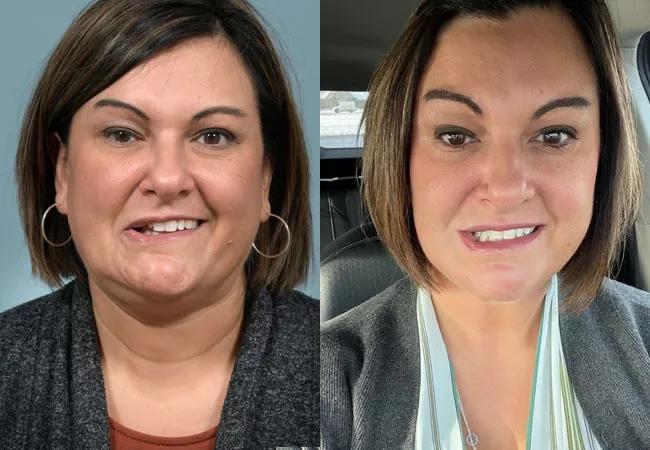For patients who had been told they didn’t have any treatment options, selective neuromyectomy is a welcome development

One of the more frightening aspects of Bell’s palsy for patients is that the symptoms and paralysis often appear out of the blue. Fortunately, for most patients, this paralysis is only temporary. But for a small number of patients with Bell’s palsy, the dysfunction becomes permanent. Many of these patients are told that there isn’t anything that can be done and are forced to live with the fallout from having facial paralysis. However, Patrick Byrne, MD, MBA, the Chairman of Cleveland Clinic’s Head & Neck Institute believes it’s important that these patients and their care providers understand that there are treatment options available to these patients.
Advertisement
Cleveland Clinic is a non-profit academic medical center. Advertising on our site helps support our mission. We do not endorse non-Cleveland Clinic products or services. Policy
Initially, Bell’s palsy presents as the sudden onset of complete facial paralysis. This frightening condition is a diagnosis of exclusion – after other potential causes of facial paralysis are ruled out. Bell’s palsy patients suffer in a number of ways. Most commonly, the facial function returns over the course of weeks to months. For many patients, the recovery is complete. For some, there are long-term challenges.
Patients with long-term sequelae from Bell’s palsy often present with what has been described as a sort of “frozen face.” This includes upper and lower eyelids that tend to constrict. So every time they’re talking or chewing, their eyes squint closed. Dr. Byrne notes that patients with Bell’s palsy often have trouble with their vision because the eyelids tend to close too much. Initially, they can’t close their eyes, but this evolves into an eye that squints too much. “Essentially, it’s the worst of both situations — they’re not blinking effectively, so their eye feels sort of dry, but also it looks funny and they have trouble seeing because the eye is squinting,” says Dr. Byrne. “But what I tend to hear most often from these patients is that they just want their smiles back. They’re not seeing the movement, the dynamism, the natural expression of emotion, they’re not seeing their teeth like they used to, and it can look strange or contorted.”
Because Bell’s palsy tends to resolve itself in most patients, Dr. Byrne suggests taking a conservative treatment approach at first. He notes that facial retraining works particularly well. Botox can also be very helpful because the areas that are squinting around the eye and are tight, can be relaxed a little bit. The areas on the other side of the face can also be weakened in order to make the space look more symmetrical and balanced. “Chemodenervation can be very effective in most Bell’s palsy patients. It allows us to restore balance – to help the patient achieve more symmetry of the upper and lower face. This is really very helpful”
Advertisement
However, for a small portion of patients with Bell’s palsy, the symptoms do not improve sufficiently despite time, facial retraining, and botox. For these patients, Dr. Byrne is a proponent of selective neuromyectomy, also called selective neurolysis. “The technique is relatively new; it’s been around since 2017. But the basic concept is that we surgically identify all of the facial nerve branches that provide input to the mid and lower face,” explains Dr. Byrne. “We map them out with the help of technology in the operating room. And then we selectively disconnect and even remove small portions of multiple nerve branches that are counterproductive to a more effective smile and facial expression.”
The outpatient procedure usually takes around two hours to perform. Dr. Byrne and his team also offer to some patients a simpler procedure that can be done in the office setting. An area inside the mouth is numbed, and the specialist can remove some of the muscle that is counter-acting against a more natural smile directly through a little incision inside the mouth. Although this method is not as complete as the selective neuromyectomy procedure, it’s also more focused.
Dr. Byrne notes that he and the other facial plastic surgeons within the Cleveland Clinic Head and Neck Institute will sometimes combine the procedure with Botox and other aesthetic procedures. Many patients choose to also undergo face-lifts, neck-lifts, eyelid surgery and injectable filler.
“The vast majority of patients experience a more natural smile, a more balanced facial expression and they feel more comfortable,” says Dr. Byrne. “We can often really transform people through these efforts, and I’ve been very impressed with the procedure. This is a very exciting time because we are finally able to offer these patients a treatment option rather than simply telling them things like ‘you look fine’ and ‘it’s not that noticeable.’ Very few places are using these broad ranges of techniques right now, but Cleveland Clinic is one of them. So right now, the focus is on raising awareness of these effective options both among referring physicians and also letting patients who felt that they were out of options to know we can help them.”
Advertisement
Advertisement

Case study illustrates the potential of a dual-subspecialist approach

Evidence-based recommendations for balancing cancer control with quality of life

Study shows no negative impact for individuals with better contralateral ear performance

HNS device offers new solution for those struggling with CPAP

Patient with cerebral palsy undergoes life-saving tumor resection

Specialists are increasingly relying on otolaryngologists for evaluation and treatment of the complex condition

Detailed surgical process uncovers extensive middle ear damage causing severe pain and pressure.

Despite advancements in the specialty, patient-centered care needs to remain a priority